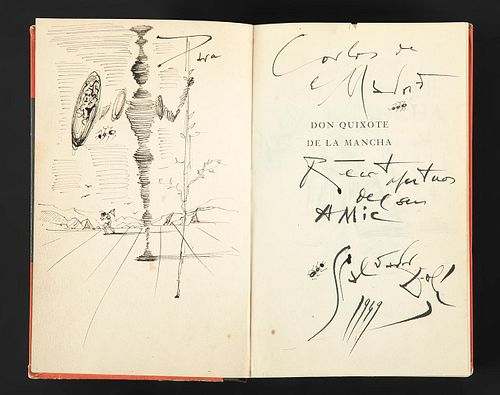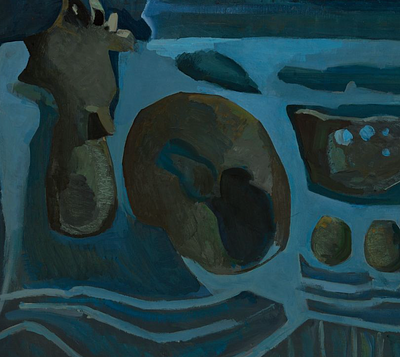SALVADOR DALÍ I DOMÈNECH (Figueres, Girona, 1904 - 1989). "Don Quixote of La Mancha". Ink drawing on paper on page of "Don Quixote", 1949. Signed and
Lot 41
About Seller
Setdart Auction House
Carrer Aragó 346
Barcelona
Spain
Setdart Subastas was born in 2004 and is currently the first online art auction in Spain with solidity, prestige and reliability guaranteed by our more than 60,000 users. Setdart has a young, dynamic and enterprising team ready to successfully manage the purchase and sale of art works through custom...Read more
Categories
Estimate:
EUR€4,000 - EUR€5,000
$4,166.67 - $5,208.33
Absentee vs Live bid
Two ways to bid:
- Leave a max absentee bid and the platform will bid on your behalf up to your maximum bid during the live auction.
- Bid live during the auction and your bids will be submitted real-time to the auctioneer.
Bid Increments
| Price | Bid Increment |
|---|---|
| EUR€0 | EUR€10 |
| EUR€200 | EUR€25 |
| EUR€500 | EUR€50 |
| EUR€1,000 | EUR€100 |
| EUR€3,000 | EUR€200 |
| EUR€5,000 | EUR€500 |
| EUR€10,000 | EUR€1,000 |
| EUR€20,000 | EUR€2,000 |
| EUR€50,000 | EUR€5,000 |
About Auction
By Setdart Auction House
Jul 27, 2021
Set Reminder
2021-07-27 08:00:00
2021-07-27 08:00:00
America/New_York
Bidsquare
Bidsquare : CONTEMPORARY AND ACTUAL ART
https://www.bidsquare.com/auctions/setdart-auction-house/contemporary-and-actual-art-7261
Setdart Auction House sofia@setdart.com
Setdart Auction House sofia@setdart.com
- Lot Description
SALVADOR DALÍ I DOMÈNECH (Figueres, Girona, 1904 - 1989). "Don Quixote of La Mancha". Ink drawing on paper on page of "Don Quixote", 1949. Signed and dedicated. Size: 19 x 12,5 x 3 cm. The fascination that Salvador Dalí felt for Don Quixote de la Mancha was materialized in the multiple drawings, sketches, engravings and sculptures that the surrealist genius dedicated to Cervantes' character. In 1945, Salvador Dalí, attracted by the fervent personality of the Ingenious Hidalgo and influenced by the advice of his father, who had assured him that "Don Quixote was a work in which the faculties could easily excel", made 38 drawings and watercolors to illustrate the first part of Cervantes' text. That original copy, today preserved in the Dalí Theater-Museum, narrated the exploits that Miguel de Cervantes wrote in 1605, and which gave rise to the modern novel that, even today, tops the list of the best literary works in history. The book in question has an original drawing by Salvador Dalí inside: it is a personification of the Knight Errant based on a whirlpool of agile and carefree forms. During his early years, Dalí discovered contemporary painting during a family visit to Cadaqués, where he met the family of Ramon Pichot, an artist who regularly traveled to Paris. Following Pichot's advice, Dalí began to study painting with Juan Núñez. In 1922, Dalí stayed at the famous Residencia de Estudiantes in Madrid to begin studying Fine Arts at the San Fernando Academy. However, before his final exams in 1926, he was expelled for claiming that there was no one there fit to examine him. That same year Dalí traveled to Paris for the first time. There he met Picasso, and established some formal characteristics that would become distinctive of all his work from then on. His language absorbed the influences of many artistic styles, from classical academicism to the most groundbreaking avant-garde. At that time, the painter grew an eye-catching moustache imitating Velázquez's, which would become his personal trademark for the rest of his life. In 1929, Dalí collaborated with Luis Buñuel in the making of "An Andalusian Dog", in which scenes from the surrealist imaginary were shown. In August of that same year he met his muse and future wife Gala. During this period, Dalí held regular exhibitions in both Barcelona and Paris, and joined the surrealist group based in the Parisian neighborhood of Montparnasse. His work greatly influenced the direction of surrealism for the next two years, and he was hailed as the creator of the paranoiac-critical method, which was said to help access the subconscious by releasing creative artistic energies. In 1931 Dalí painted one of his most famous works, "The Persistence of Memory", in which, according to some theories, he illustrated his rejection of time as a rigid or deterministic entity. The painter landed in America in 1934, thanks to art dealer Julian Levy. As a result of his first individual exhibition in New York, his international projection was definitively consolidated, and from then on he would show his work and give lectures all over the world. That same year he was subjected to a "surrealist trial" which resulted in his expulsion from the movement, because the painter considered that surrealism could exist in an apolitical context, refusing to commit himself to the ideas of André Breton. To this, Dalí responded with his famous retort, "I am surrealism". Most of his production is gathered in the Dalí Theater-Museum in Figueras, followed by the collection of the Salvador Dalí Museum in St. Petersburg (Florida), the Reina Sofía in Madrid, the Salvador Dalí Gallery in Pacific Palisades (California), the Espace Dalí in Montmartre (Paris) or the Dalí Universe in London.
- Shipping Info
-
In-house shipping available. Please inquire at admin@setdart.com.
-
- Buyer's Premium



 EUR
EUR CAD
CAD AUD
AUD GBP
GBP MXN
MXN HKD
HKD CNY
CNY MYR
MYR SEK
SEK SGD
SGD CHF
CHF THB
THB

















